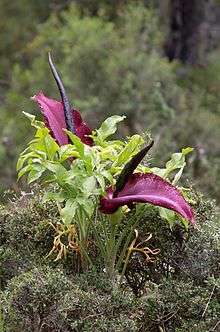Dracunculus vulgaris
Dracunculus vulgaris is a species of aroid in the genus Dracunculus and is known variously as the common dracunculus, dragon lily, dragon arum, the black arum, the voodoo lily, the snake lily, the stink lily, the black dragon, the black lily, dragonwort, and ragons. In Greece, part of its native range, the plant is called drakondia, the long spadix being viewed as a small dragon hiding in the spathe.[1]
| Dracunculus vulgaris | |
|---|---|
 | |
| Scientific classification | |
| Kingdom: | Plantae |
| Clade: | Tracheophytes |
| Clade: | Angiosperms |
| Clade: | Monocots |
| Order: | Alismatales |
| Family: | Araceae |
| Genus: | Dracunculus |
| Species: | D. vulgaris |
| Binomial name | |
| Dracunculus vulgaris | |
It is endemic to the Balkans, extending as far as Greece, Crete, and the Aegean Islands, and also to the south-western parts of Anatolia.[1]
Description
Female flowers (at the bottom)
The species is characterized by a large purple spathe and spadix, which has a very unpleasant smell reminiscent of rotting meat to attract flies (Lucilia and others) as pollinators. The large palmate leaves have occasional cream flecks along the veins.
The dragon lily has the ability to heat itself to a temperature of 18 degrees Celsius. This addition to its traits does not have any correlation to its potent scent, however it does promote the comfort of the insects who choose to pollinate on the lily.
Cultivation
Dracunculus vulgaris has been introduced to northern Europe, and North America, both to the United States, where it is present in the states of Kansas, Oregon, California, Washington, South Carolina, Tennessee, Kentucky, Michigan, Ohio, the commonwealth of Puerto Rico,[2] and to Canada, where it has been grown in the province of Ontario.
The plant can tolerate some shade but prefers full sun; it can also withstand drought but benefits from a little watering. The plant prefers a humus-rich, well-drained soil.
References
- Dragon Arum Archived June 19, 2008, at the Wayback Machine at blueworldgardener.co.uk
- PLANTS Profile for Dracunculus vulgaris (common dracunculus)
External links
- Calorimetric investigations of the pollination biology of the thermogenic inflorescences of the dragon lily (Dracunculus vulgaris) and its pollinator (Protaetia cretica) on Crete
- Respiration, Temperature Regulation and Energetics of Thermogenic Inflorescences of the Dragon Lily Dracunculus Vulgaris (Araceae)
